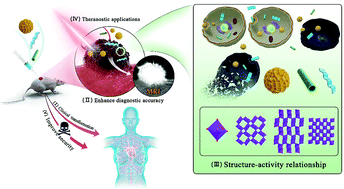Nanostructured manganese dioxide for anticancer applications: preparation, diagnosis, and therapy†
Abstract
Nanostructured manganese dioxide (MnO2) has attracted extensive attention in the field of anticancer applications. As we all know, the tumor microenvironment is usually characterized by a high glutathione (GSH) concentration, overproduced hydrogen peroxide (H2O2), acidity, and hypoxia, which affect the efficacy of many traditional treatments such as chemotherapy, radiotherapy, and surgery. Fortunately, as one kind of redox-active nanomaterial, nanostructured MnO2 has many excellent properties such as strong oxidation ability, excellent catalytic activity, and good biodegradability. It can be used effectively in diagnosis and treatment when it reacts with some harmful substances in the tumor site. It can not only enhance the therapeutic effect but also adjust the tumor microenvironment. Therefore, it is necessary to present the recent achievements and progression of nanostructured MnO2 for anticancer applications, including preparation methods, diagnosis, and treatment. Special attention was paid to photodynamic therapy (PDT), bioimaging and cancer diagnosis (BCD), and drug delivery systems (DDS). This review is expected to provide helpful guidance on further research of nanostructured MnO2 for anticancer applications.

- This article is part of the themed collection: Recent Review Articles


 Please wait while we load your content...
Please wait while we load your content...